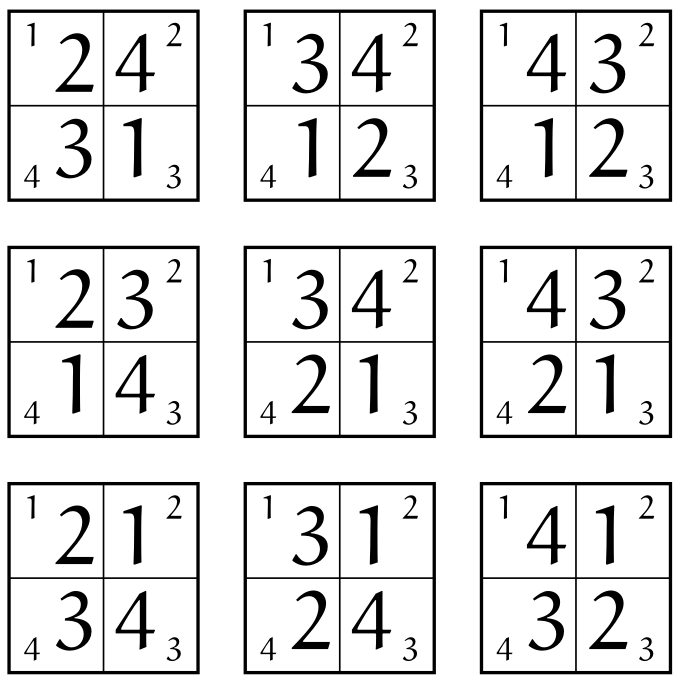• 9 can be written using four 4's:

• There are 9 triangles with integer sides and perimeter less or equal to 9.
• Every natural number can be written as the sum of at most 9 cubes.
• There are 9 derangements of four objects, i.e., permutations in which no item remains in its original position.

9 has 3 divisors (see below), whose sum is σ = 13. Its totient is φ = 6.
The previous prime is 7. The next prime is 11.
The square root of 9 is 3.
It is a perfect power (a square), and thus also a powerful number.
9 is nontrivially palindromic in base 2 and base 8.
9 is digitally balanced in base 2, because in such base it contains all the possibile digits an equal number of times.
It is a Cunningham number, because it is equal to 23+1.
9 is an esthetic number in base 4, base 7 and base 9, because in such bases its adjacent digits differ by 1.
It is a semiprime because it is the product of two primes, and also a brilliant number, because the two primes have the same length.
It is an interprime number because it is at equal distance from previous prime (7) and next prime (11).
It is a tau number, because it is divible by the number of its divisors (3).
It is the 4-th Motzkin number.
It is a Cullen number, since it is equal to 2×22+1.
It is a trimorphic number since its cube, 729, ends in 9.
It is not a de Polignac number, because 9 - 21 = 7 is a prime.
It is a Harshad number since it is a multiple of its sum of digits (9).
It is a super Niven number, because it is divisible the sum of any subset of its (nonzero) digits.
It is a nude number because it is divisible by every one of its digits and also a Zuckerman number because it is divisible by the product of its digits.
9 is an idoneal number.
It is (trivially) a d-powerful number and an alternating number.
It is a D-number.
It is one of the 548 Lynch-Bell numbers.
It is a house number.
It is a Duffinian number.
It is a Curzon number.
9 is a lucky number.
9 is a nontrivial repdigit in base 8.
It is a plaindrome in base 5, base 6, base 7 and base 8.
It is a nialpdrome in base 3, base 4, base 8 and base 9.
It is a zygodrome in base 8.
It is a self number, because there is not a number n which added to its sum of digits gives 9.
It is a panconsummate number.
It is a Kaprekar number, because its square (81) can be partitioned into two parts whose sum is 9.
It is a pernicious number, because its binary representation contains a prime number (2) of ones.
It is a subfactorial, being equal to the number of derangements of 4 objects .
It is a polite number, since it can be written in 2 ways as a sum of consecutive naturals, for example, 2 + 3 + 4.
It is a (trivial) narcissistic number.
It is a Proth number, since it is equal to 1 ⋅ 23 + 1 and 1 < 23.
9 is the 3-rd square number and also the 2-nd nonagonal number.
9 is the 2-nd centered octagonal number.
It is an amenable number.
9 is a deficient number, since it is larger than the sum of its proper divisors (4).
9 is a wasteful number, since it uses less digits than its factorization.
With its successor (10) it forms an eRAP, since the sums of their prime factors are consecutive (6 and 7).
With its predecessor (8) it forms a Ruth-Aaron pair, since the sum of their prime factors is the same (6).
9 is an evil number, because the sum of its binary digits is even.
The sum of its prime factors is 6 (or 3 counting only the distinct ones).
The product of its digits is 9, while the sum is 9.
The cubic root of 9 is about 2.0800838231.
The spelling of 9 in words is "nine", and thus it is an aban number, an oban number, and an uban number.
• e-mail: info -at- numbersaplenty.com • Privacy notice • done in 0.067 sec. • engine limits •

